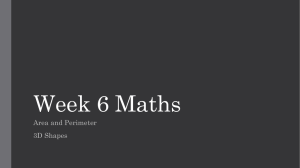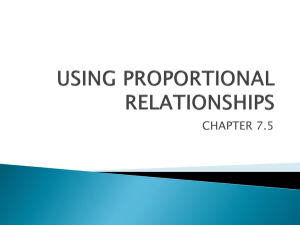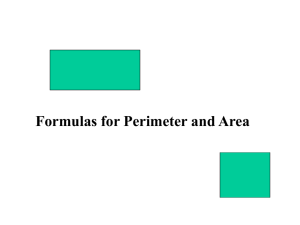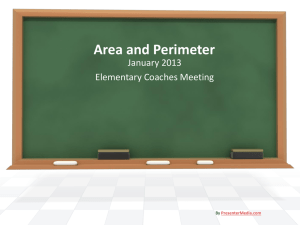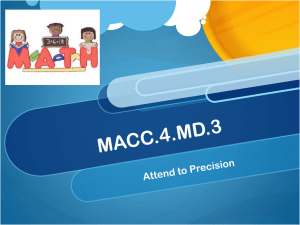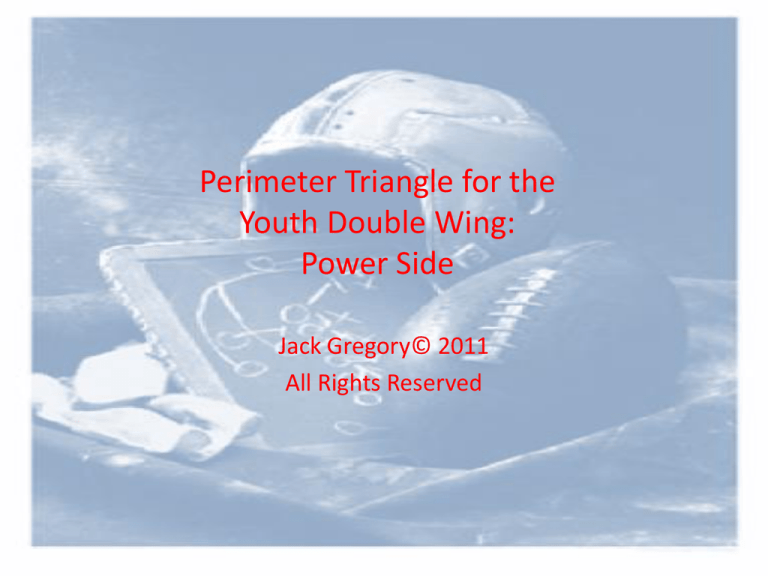
Perimeter Triangle for the
Youth Double Wing:
Power Side
Jack Gregory© 2011
All Rights Reserved
Introducing the Perimeter Triangle
• The “perimeter triangle” is a term I started using to describe the
three most common players defending the perimeter - typically in
contain, force and alley
• Every defense must have these three assignments covered or risk
the possibility of having the exposed perimeter exploited by the
offense.
• The perimeter triangle is typically manned by the:
– defensive end (DE),
– cornerback (CB)
– outside linebacker (OLB). (sometimes a Safety)
• I wanted a simple method of determining what these defenders
were doing on the perimeter as this would determine how I would
attack the defense from play to play.
• Power Side and Counter (back) Side
Topics of Discussion
• develop an understanding of the function of the
perimeter triangle in the defense,
• develop an ability to read the perimeter triangle
as a means of deciphering the defensive scheme,
• develop an ability to optimize play calling based
on the perimeter triangle read, and
• develop an ability to use formations, motions,
and play-calling to manipulate the perimeter
triangle and expose vulnerabilities in the
defense.
Introducing the Perimeter Triangle
Outside hip of OT
Perimeter Triangle – The defensive end, cornerback, and outside linebacker
typically comprise an entity that I define as the Perimeter Triangle.
Why Use The Perimeter Triangle
• I wanted a simple method of determining what these defenders
were doing on the perimeter as this would determine how I would
attack the defense. Remember our base play is POWER!
• It is very important that the offensive coordinator be able to quickly
adapt to the defense, to attack and counterattack.
• Often as youth coaches we need to be able to do it from the
sideline as we are not likely to have scouting assistance from an
elevated position. This is specifically why I developed the concept of
the perimeter triangle.
• Helps to quickly identify a neutral, heavy or light perimeter so that
you immediately know how to attack that side.
• In developing an understanding of the perimeter triangle, one can
effectively read the defense and make informed play calling
decisions that have the highest likelihood of success.
2-3-4 Rule
• 2 or less defenders outside of OT: ATTACK PERIMETER
• 3 defenders outside of OT: ATTACK EDGE
• 4 or more defenders outside of OT: ATTACK INSIDE
or AWAY or PASS (safety filling)
• If 4 locate where they came from: safety support?,
shifted backers?, shifted line?, cowboy corner?
• Count perimeters, locate safety(s), gives you the
defenders remaining that are protecting the interior.
Elements of the Perimeter Triangle
• Contain – This is the defender who has the job of keeping
the ball inside and/or behind the line of scrimmage. He
must keep the ball on his inside shoulder and not allow it to
get past him at any time.
• Force – The force defender’s job is to turn the ball back
inside (squeeze) or deep outside and towards the line of
scrimmage (spill).
• Alley – This responsibility may be assumed by an interior
linebacker, or possibly a safety playing near the LOS and the
perimeter; but it is more than likely the responsibility of an
outside linebacker. The alley defender’s main role on the
perimeter is to maintain a mirrored relationship with the
ball.
Variations in the Elements
Three basic defensive perimeter schemes:
– Spill: Force defender inside of Contain defender.
More aggressive (attack) scheme.
– Squeeze: Contain defender inside of Force
defender. More of a read and contain scheme.
– Box: Contain defender inside of Force defender.
Contain works vertically up field to seal off sweep.
More of a contain and read scheme.
Know The Perimeter Scheme
• Most youth teams play a squeeze perimeter or
a box scheme. (CONTAIN/FORCE).
– This means they are often neutral (3) or heavy (4);
due to line shift or secondary run support.
• Aggressive DE play (crash, pinch, hunt) are
playing a spill scheme. (FORCE/CONTAIN)
– This means they are often light (2) or neutral (3);
due to line shift or secondary run support.
Game Film Review
Understanding the Perimeter Triangle
• Regardless of the defensive alignment, every legitimate
defense has a ‘contain’, ‘force’, and ‘alley' defender on
each side of the ball. The arrangement of those
defenders often determines how the defense will play
the perimeter, edge and pass.
• There are occasions when defenses will swap these
players around such that the defensive end is the force
player and the corner is the contain player; or
alternatively, the outside linebacker will swap with the
defensive end, etc.
• Regardless of the scheme, these three elements are
always in place – contain, force and alley.
Understanding the Points of Attack
Perimeter
Edge
LWB (20)
Interior
QB (10)/BB (30)
Edge
Perimeter
RWB (40)
‘Perimeter’ extends from the outside hip of the tight end (or EMLOS) to the sideline. Any play that we
use that aims for the outside hip of the tight end (EMLOS) will be a ‘perimeter’ play.
The ‘edge’, which is the primary point of attack for this offense, extends from the outside hip of the
guard to the outside hip of the tight end.
Anything within the inside hip of the guard is considered an ‘interior’ play.
That is really all you need to know about how we target the attack of the defense on each side, as far
as the running game goes.
Understanding the Points of Attack
Cont’d
Vertical Out
Perimeter
Vertical Middle
Edge
Interior
Vertical Out
Edge
Perimeter
Most common point of attack is the perimeter (also called the flat)
Followed by the vertical outs (from the outside hip of the tight end to the boundary)
Vertical middle (from the inside of the tight end’s outside hip on each side).
Reading The Perimeter Triangle
• Power side: power/power sweep/power pass is being ran to.
– WB/QB SEAL (power)
– WB WIDE/MS (power sweep)
– Power Pass (WB PP) (power pass)
• Counter side (backside): side counter/counter trap/reverse
(backside audibles) being ran to.
– WB KICK
– WB WIDE REVERSE
• Interior: wedge and counter trap
– BB/QB WEDGE
– BB KICK
• Initially: Pre-snap read (basic read)
• Developing: Post-snap read (advance read)
Reading the Perimeter Triangle
Cont’d
• The concept of the perimeter triangle provides a foundation
wherein we can read each side of the defense and resolve
play calling decisions based on how many players are in the
respective perimeter triangles.
• You really don’t need to know specifically who is playing what
technique. All you really need to do is simply count the
defenders that are in the perimeter pre-snap and eventually
post-snap.
Tight Rip 26 Seal Right
Counter Side
Symmetrical backfield
Power side
Shift Rip 26 Seal
Counter Side
Asymmetrical backfield
Power side
3 On the Edge
3
2
3
1
2
1
SHIFT RIP
4 & 2 on Edge
2
1
4
1
SHIFT RIP
2
5
3
Applying Stress to the Perimeter
Triangle
• It is not sound to sit in one formation and expect the defense to not adapt
to your method of play calling and play execution.
• Human beings are creatures of adaption and athletes are the best
example of creatures of instantaneous adaption.
• Edge tags are a very simple away of changing the perimeter appearance of
a formation while the base play structure stays sound. (pre-snap)
• Formation tags are another simple method of changing the backfield
appearance so that a formation is no longer symmetrical (tight) and it
offers a LOF (line of force) advantage to the offense and specifically the
play. (pre-snap)
• Play tags are a final example of placing post-snap stress on a perimeter by
movement. (post-snap)
Applying Stress to the Perimeter
Triangle Cont’d
• There a two ways to attack a perimeter triangle.
• First is to isolate the perimeter triangle away from the
interior defenders. The use of ON, OVER, and NASTY
edge tags is a great way of accomplishing this pre-snap.
• Second is to expand the triangle so that you isolate the
defenders within the perimeter triangle away from each
other. The use of SPLIT, FLANKER, NASTY, LOOSE, TRIPS,
and BUNCH edge tags is a great way of accomplishing
this pre-snap.
• The 1st level defender is always the primary defender we
must account for. If we don’t open the 1st level the play
will not work!
Applying Stress to the Perimeter
• Edge Tags: the means to remove defenders
– OVER: BST over, unbalanced line, overloaded TKO wall.
– NASTY: WB & TE exchange positions. Extends DE out or
places him inside of TE.
– LOOSE: WB and TE become SLOT and SE. Removes the CB
and OLB from the edge.
– SPLIT: TE becomes SE removes CB.
– FLANK: WB becomes FLANKER removes CB.
– TRIPS: TE becomes SE, PSWB becomes outside slot, BSWB
becomes inside slot.
– BUNCH: TE becomes SE (#2/middle receiver), PSWB
becomes outside bunch slot (#1). BSWB becomes inside
bunch slot (#3).
Applying Stress to the Perimeter
• Backfield Alignments
–
–
–
–
–
–
–
–
–
TIGHT: classic DW – never actually call it.
STACK: stack I, BB-BSWB-PSWB
PRO: pro set, PSWB, and BB on play side in front of BB
WISH: wishbone: BSWB-BB-PSWB
BEAR/BULL: strong I, BB offset, WB, BSWB at I.
SHIFT: direct snap
STAR: direct snap (double WB)
NOVA: direct snap (variation of Hugh Wyatt Wild Cat)
COMET: direct snap Yale/Beast
OVER
BSWB, QB, BB, PSWB
Nasty
BSWB, QB, BB, PSWB
Loose
BSWB, QB, BB, PSWB
Flanker
BSWB, QB, BB, PSWB
Split
BSWB, QB, BB, PSWB
Trips
BSWB, QB, BB, PSWB
Bunch
BSWB, QB, BB, PSWB
Tight
Formation tag
BSWB, QB, BB, PSWB
Stack
Formation tag
BSWB, QB, BB, PSWB
Pro
Formation tag
BSWB, QB, BB, PSWB
Wish
Formation tag
BSWB, QB, BB, PSWB
Bear
Formation tag
BSWB, QB, BB, PSWB
Bull
Formation tag
BSWB, QB, BB, PSWB
Shift
Formation tag
BSWB, QB, BB, PSWB
Star
Formation tag
BB, QB, BSWB, PSWB
Comet
Formation tag
BB, QB, BSWB, PSWB
Nova
Formation tag
BSWB, QB, BB, PSWB
Game Film Review
Game Film Review
Questions/Comments?

